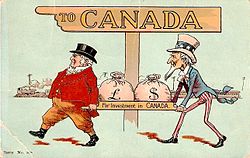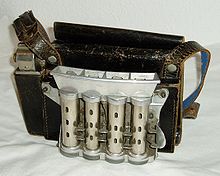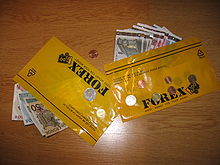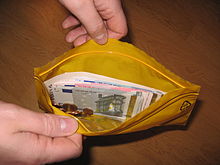- Money bag
-
"Moneybags" redirects here. For the game character, see Moneybags (Spyro character). For the rapper, see E-Moneybags."Money purse" redirects here. For the money won as a prize, sometimes referred to as "purse money", see prize money.
 Saint Homobonus' (died 1197) attributes include a bag of money
Saint Homobonus' (died 1197) attributes include a bag of money
A money bag (moneybag, bag of money, money sack, sack of money, bag of gold, gold bag, sack of gold, etc.) is a bag (normally with a drawstring) of money (or gold) used to hold and transport coins and banknotes from/to a mint, bank, ATM, milled, business, or other institution.[1][dead link] Money bags are usually transported in an armored car or a money train and, in the past, via stagecoach.
A money bag can be road debris after it falls out of an armored truck,[2] causing a traffic accident[3] or mass hysteria often compared to a feeding frenzy, as people rush to pick up "free" money.[4]
Crumillospongia is a genus of middle Cambrian sponge named after its similarity to a small leathery money purse, or crumilla (Latin for "small, little purse").[5][6]
Contents
History
According to the account given in the Bible's Gospel of John, Judas Iscariot carried the disciples' money bag.[7]
During the Roman era, the Legio IV Scythica was camped in Zeugma, an ancient city of Commagen (modern-day Turkey). Excavations carried out in the city revealed 65,000 seal imprints (in clay, known as “Bulla”) found in a place which is believed to serve as the archives for the customs of ancient Zeugma. The seal imprints used in sealing papyrus, parchment, moneybags, and customs bales are good indication of volume of the trade and the density of transportation and communication network once established in the region.
Charon's obol, a death custom originating in ancient Greece whereby a coin is placed with a corpse, in the 3rd-4th century AD in Western Europe, were often found in pouches, making them money pouches. From the Middle Ages to around 1900, Rottweiler dogs were used by travelling butchers at markets to guard money pouches tied around their necks.[8]
Beginning in the 14th century, purses of money (panakizhi) were awarded to scholars during the Revathi Pattathanam, an annual assembly of scholars held in Kerale, India. In 16th century feudal Japan, samurai wore uchi-bukuro (money purses) around the waist or neck.
In 1620, pediatric tracheotomy was unheard of until a boy tried to hide a bag of gold by swallowing it. It became lodged in his esophagus and blocked his trachea. The tracheotomy allowed the surgeon to manipulate the bag and it to pass through his system.[9] In September 1864, Rose O'Neal Greenhow, a Confederate agent, drowned with a bag of gold around her neck after leaving the Condor (a British blockade runner ship) in a boat.
Nickname
A wealthy person can have the nickname "moneybag" (or "moneybags").[10][11] Marcus Licinius Crassus (c. 115-53 BC), a leading Roman politician in his day, was known in Rome as Dives, meaning "The Rich" or "Moneybags". Ivan I of Moscow ("Ivan the Moneybag") was a Russian "Grand Prince of Moscow" from 1328-1341 who was famous for being generous with his wealth. American Cardinal Francis Spellman (1889–1967) was sometimes called "Cardinal Moneybags" in his later life, while Chicago mobster and racketeer Murray Humphreys (1899–1965) was referred to as "Mr. Moneybags" by his friends. Miss Moneybags (played by Edna Purviance) is a fictional character in the 1915 Charlie Chaplin silent comedy film The Count. James Edward "Baron of Edgerton" Hanson's (1922–2004) billion-dollar empire earned him the nickname "Lord Moneybags". Another fictional character, Victor Newman (Eric Braeden) of The Young and the Restless soap opera, has also been called "Moneybags".
In popular culture
 Postcard (postmarked 1907) depicting John Bull and Uncle Sam under sign "To Canada" bringing in sacks of money "for investment in Canada"
Postcard (postmarked 1907) depicting John Bull and Uncle Sam under sign "To Canada" bringing in sacks of money "for investment in Canada"
Money bags have been represented in art and culture throughout human history, including paintings, literature, film, television, games, and even food.
- Wedding Painter, the conventional name for an ancient Greek vase painter active in Athens from circa 480 to 460 BC, painted a money bag on a vase.
- A leno, a theatre of ancient Rome stock character (1st century BC to 5th century AD), is often depicted carrying a money bag.
- Jainism sculpture (c.10th-11th centuries AD) shows various Jain gods (Yaksa Sarvanubhuti) and/or their attendants/servants, holding money bags (chowrie, noli),[12] purses (nakulika),[13] or "purse-like objects"[14] Buddhist (Pañcika and Vaiśravaṇa/Jambhala) and Hindu (Kubera) deities/gods/goddesses have money bags (or purses or their equivalent--"bag/sheath of jewels", etc.) as part of their iconography. Lugus, another god worshipped by Celtic people and identified with Mercury, the Roman god of commerce (Gaulish Mercury, in particular), is depicted carrying a money bag.
- Around 1130, Hugh of St. Victor's Chronica's preface refers to a money bag (sacculus or sacculum in Latin), with its compartments, as a memory training analogy.[15]
- The Prague Astronomical Clock (c. 1490) has an animated figure holding a bag of gold
- In the 16th century, The Conjurer, a painting by Hieronymus Bosch, features a child stealing a money purse from a bespectacled character.
 In A new way to pay the National Debt (1786), James Gillray caricatured King George III and Queen Charlotte awash with treasury funds to cover royal debts, with William Pitt handing him another moneybag.
In A new way to pay the National Debt (1786), James Gillray caricatured King George III and Queen Charlotte awash with treasury funds to cover royal debts, with William Pitt handing him another moneybag.
- Around 1791, James Gillray published a cartoon about reaction to the Boydell Shakespeare Gallery labelled "Boydell sacrificing the Works of Shakespeare to the Devil of Money-Bags".
- Jack and the Beanstalk (c. 1807), this English fairytale's main character, Jack, takes a bag of gold coins as he escapes from the giant's castle
- The Princess Who Never Smiled (c. 1855), a Russian fairy tale about a princess and a worker who takes coins from a sack of money
- The Apotheosis of Washington (1865), a fresco in the dome in the rotunda of the United States Capitol Building that contains a commerce scene with the Roman god Mercury holding a bag of gold.
- The obverse 1896 US Educational Series $2 bill shows an allegorical figure of Commerce who has a bag of money next to her, making it a picture of a bag of money on real money.
- A Bag of Gold (1915), film starring Sidney Ainsworth
- In 1917, Marcel Duchamp created "Fountain", a modern-art readymade sculpture, and signed it "R. Mutt". The R stands for "Richard", which is French slang for "Moneybags".
- In the 1920s, Loft's produced the first chocolate coins, called gelt (which can come in plastic mesh bags[16]).
- In 1974, Herb Block produced Herblock Special Report, a book of political cartoons and text about Richard Nixon with some cartoons featuring money bags.[17]
- "Bag Full of Money" (1972) is a rock song recorded by The Byrds and released on the 2000 reissue of their 1971 album Farther Along after having already been released by former lead singer/guitarist Roger McGuinn on his 1973 self-titled album.
- "Bag of Money" (1977), pop song by Brotherhood of Man from their album Oh Boy!
- Gene Simmons' Simmons Records logo[18]
- The Phoenix, an Irish news and satire magazine started in 1983, has a financial column called "Moneybags"
- Money for Nothing (1993), comedy/crime film about Joey Coyle (John Cusack) who finds $1.2 million dollars in a bag in the middle of the street after it falls out of the back of an armored car
- Leprechaun (1993), horror film about a leprechaun who had his bag of gold coins stolen and tries to get it back
- The Black Book (1993), crime novel by Ian Rankin about "Operation Moneybags", a police investigation aimed at putting a money-lender out of business
- Life Underground (2001), a permanent public artwork created by American sculptor Tom Otterness for the 14th Street–Eighth Avenue New York City Subway station, features characters with money bag heads
- 29 Palms (2002), direct-to-video film about a bag of money that affects the characters who possess it
- Thai money bag (tung tong, or toong tong, ถุงทอง), a small, crispy, deep-fried pastry purse [shaped like a money bag] with various filling (circa unknown)
- The 2004 British Comedy-drama film, Millions, is about two boys that find a bag full of money thrown from a train during a robbery.
- In a 2005 episode of Disney Channel's That's So Raven entitled Extreme Corey, Corey joins an "extreme" skateboarding group and asks for the nickname Moneybagz.
- In the ninth season (2005) of Comedy Central's South Park, in an episode entitled "Two Days Before the Day After Tomorrow", Cartman tries to stop Kyle at gunpoint, demanding he give up his "Jew gold". It turns out that Kyle not only has a bag of gold (which he wears round his neck at all times), but a decoy bag as well. This highlights the issue of as well as parodying of anti-Semitism portrayed by Eric Cartman.
- Dean Accessories makes a handbag from recycled decommissioned US mint money bags.[19]
Gaming
In various games, money bags (or bags of gold) tend to be used to represent treasure or points. In board games like Dungeon! (1975) a money bag is a treasure card, in Talisman (1983) as a card, and in Monopoly as a pawn/piece introduced in 1999.[20] The 1976 game television show Break the Bank had a money bag as a space and The Price is Right has a pricing game called "Balance Game". Video games such as Lock 'n' Chase (1981), Bagman (1982), Pitfall! (1982), Moneybags (1983),[21] Bank Panic (1984), Circus Charlie (1984), Gunfright (1985), Roller Coaster (1985), Arm Wrestling (1985), the Castlevania series (1986-2010+),[22] and Robin Hood: The Legend of Sherwood (2002) have money bags (or bags of gold) in them. As video game characters, Moneybags is a character in the Spyro the Dragon series and a boss named Moneybags in Dual Hearts.
See also
- Briefcase, also used to hold money
- Handbag
- Mokeskin pouch, a magical object in the Harry Potter series that resembles a money bag
- Money belt
- Purse
- Wallet
References
- ^ 26 March 2010. "Cash grab as money bag falls from truck", Channel 4 News.
- ^ Italian lorry spills two million Euros in coins, motorists cash in, Tom Phillips, Metro, 7 July 2010 (retrieved 12 August 2010)
- ^ Money Bag Falls Out Of Armored Truck, Causing Minor Fender-Benders, WRAL-TV (Raleigh, North Carolina, US), December 7, 2000
- ^ Fallen money bag sparks Ohio cash grab, BBC News, 25 March 2010
- ^ crumilla at myEtymology, retrieved 16 May 2010
- ^ crumilla at Latin Dictionary, retrieved 16 May 2010
- ^ John 12:6
- ^ Rottweiler, Encyclopædia Britannica Online, retrieved 30 April 2010
- ^ Rajesh, Orl. "Historical Review Of Tracheostomy." Internet Journal of Ophthalmology & Visual Science 4,22006 1-5. 17 Oct 2007
- ^ bag money bag, Dictionary.com, retrieved April 04, 2010
- ^ moneybags, Merriam-Webster Online Dictionary. retrieved April 4, 2010
- ^ Jaina-Rup̄a-Manḍạna, Volume 1, Umakant Premanand Shah, Abhinav Publications, 1987, pp. 48,73,116,121-2,124,156,219,220,233,326 ISBN 9788170172086 at Google Books
- ^ Shah, pages 125,130,178,181
- ^ Shah, p.161
- ^ Art of memory#Principles
- ^ Jewish Holiday Style, Rita Milos Brownstein & Donna Wolf Koplowitz, Simon and Schuster, 1999, 144 pages, pp. 58-60, ISBN 9780684849591
- ^ "I am not a crook" (Herblock's History: Political Cartoons from the Crash to the Millennium) at the United States Library of Congress, 15 Jan 2002
- ^ Sex Money Kiss Book by Gene Simmons, earcandymag.com, retrieved 12 March 2010
- ^ Recycled Bank Bag, Handbag of the Day, Deidre Woollard, Luxist.com, 4 December 2009, retrieved 12 April 2010
- ^ "A New Bag For Monopoly Game", CBS News, 17 March 1999, retrieved 14 March 2010
- ^ Moneybags at Gamebase 64, retrieved 4 April 2010
- ^ Castlevania, Mr. P's Castlevania Realm (hosted at The Video Game Museum, retrieved 12 August 2010)
External links
- moneybag at The Free Dictionary
- moneybag at Giant Bomb, video games that include money bags
- Thief Bag at TV Tropes
- Briefcase Full Of Money at TV Tropes
Bags and flexible containers Carried Handbag · Shopping bag · Briefcase · Money bag · Medical bag · Paper bag · Plastic bag · Reusable shopping bagWorn Luggage
Wikimedia Foundation. 2010.




